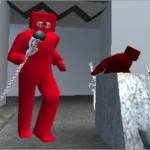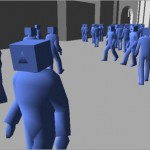The Last Story Iwata Asks details with AQ
Posted on December 9, 2010 by Brian(@NE_Brian) in News, Wii
– Hironobu Sakaguchi and AQ Interactive’s Takuya Matsumoto ended up working together on The Last Story after meetings at an izakaya restaurant in Tokyo (near Mistwalker)
– Sakaguchi was creating a design document
– Sakaguchi and Matsumoto would meet at the restaurant to talk about games
– The two had regrets about Blue Dragon (they worked on that for the Xbox 360)
– Thought they might have made the same style of game too much and took things easy
– The two discussed the new style of games
– Both were shocked by a game video they saw, after seeing the brand new style of the game
– Sakaguchi regretted that he was surprised by someone else’s work while he was the one who was supposed to surprise players
– Sakaguchi/Matsumoto agreed to make a prototype to decide on the direction to take with The Last Story
– Prototyping phase was done for around a year
– The demos had blocky characters named “Tofu”
– Sakaguchi/Matsumoto believed they needed a new battle system for The Last Story, would repeat the same mistakes if they didn’t change the basic rules
– Made a prototype with 3 blue tofus representing the heroes and 3 red tofus representing the enemies
– Glasses given to the enemy leader
– Trial and error tests with the blue and red tofus
– Would have the option of instructing your allies to kill the leader off first in the prototype
– Ability to give directions to allies became important in the final battle system
– Sakaguchi/Matsumoto also decided to work on collision work on the fields of play
– They made the game so that players can explore the reaches of fields of play (complex land formations such as hiding in shadows, turning horizontally when trying to fit through spaces, entering doors after pushing them open with their hands)
– Incorporated the land formations into the game because proper collision was done
– Players can climb over walls or hide in spaces as a result
– Collision work connected to the game’s scenario work
– Story and land formations are intertwined
– 3 steps to the story: Sakaguchi’s general outline, character exchanges in dungeons (worked on by Matsumoto), then details and voice acting
– Matsumoto took Sakaguchi’s outlines to come up with ways to incorporate the land formations into them in the form of events
– Some of what Matsumoto did led to character settings
– Elza’s habit of kicking doors in order to open them is an example of the above
– Sakaguchi believed this to be a nice element to the character and made it part of the character setting
– Matsumoto thought the Gathering component was difficult
– Gathering system comes from the game’s keyword of “Chaos and Order” or “If you bring order to the battle field that is in chaos, you will win”
– A lot of trial and error to make the gathering concept work in the battle system and become advantageous to the player
– Sakaguchi said a big problem was that the strength of the Gathering command would have to change based on the enemy and battle conditions
– Kill off enemies without using the Gathering skill
– Gathering is exclusive to Elza, but other characters use similar skills
– Make enemies drawn in to some allies to some extent
– Sakaguchi thinks that allowing players to have freedon in battles will let players have their own play style
– Staff mixed of those who would guard and use Gathering to get a grasp on the battle and others who’d just jump right in and fight
– Matsumoto used the first option
– Sakaguchi jokes that Matsumoto is making the game’s tutorial and put in a recommendation that players use Guard
– “Replay” system in the prototype phase, didn’t make it into the final game
– Replay would have the previous few seconds of battle saved to memory so that you could review what happened
– Players would be able to pick up on things they might have missed due to the chaos of battle (such as which enemy hurt you)
– Sakaguchi stopped working on because rewinding lead to bad battle tempo
– Replay system led to the element in which the action freezes and you’re given a birds eye view of the action when you input commands in battle
– Climbing walls was added after the prototype phase
– Had to redo all the early dungeons they’d created due to the added skill above
– Auto attack also added after the prototype
– Matsumoto thinks that players are able to get a better grasp of the battle situation with the auto attack\
– Auto attack is the “Normal” setting for battle
– Can switch it to “Manual”
– Manual option gives you direct button controls over your attacks
– Sakaguchi said balancing both types of attack options took a lot of time
– Team wanted to make sure that switching to manual attacks didn’t make the game easy
– Tuning the auto attack lasted through the end of development
Thanks to Thomas N for the tip!


